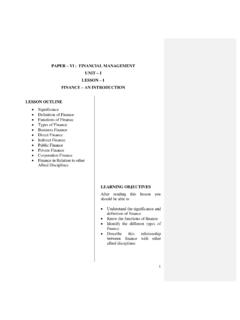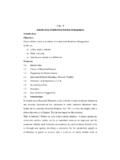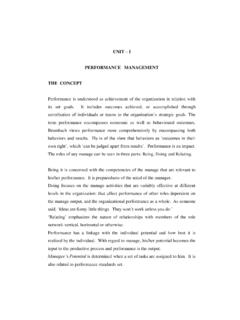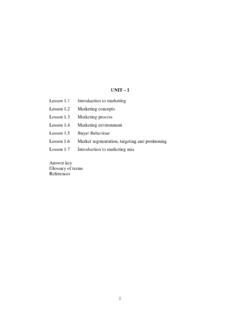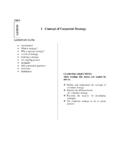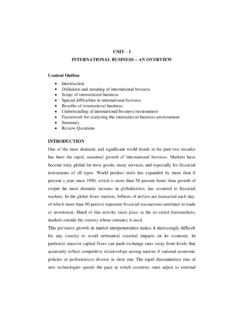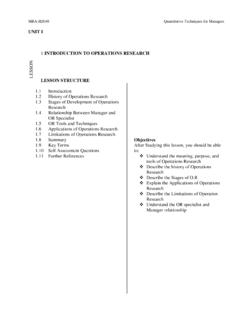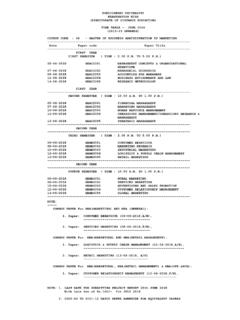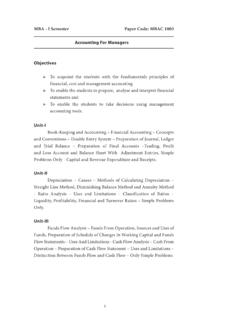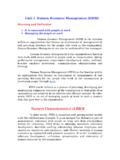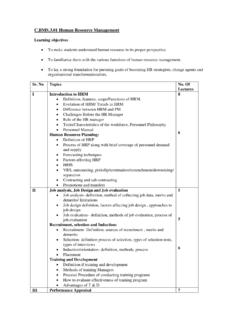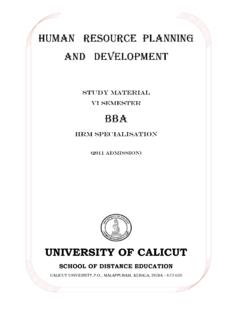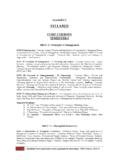Transcription of Human Resource Information system UNIT:1
1 Human Resource Information system UNIT:1 Introduction: Data & Information needs for HR Manager; Sources of Data; Role of ITES in HRM; IT for HR Managers; Concept, Structure, & Mechanics of HRIS; Programming Dimensions & HR Manager with no technology background; Survey of software packages for Human Resource Information system including ERP Software such as SAP, Oracles Financials and Ramco s Marshal [only data input, output & screens]; Learning Objectives: After reading this chapter, you should be able to understand The meaning and definition of HRIS The importance of HRIS Data and Information needs for HR manager Sources of data Concept structure and mechanics of data Survey of software packages for HRIS Basic knowledge of ERP software such as SAP, Oracles Financials and Ramco s MArshal Introduction Many well-known examples of the use of Information technology for competitive advantage involve systems that link an organization to suppliers, distribution channels, or customers.
2 In general, these systems use Information or processing capabilities in one organization to improve the performance of another or to improve relationships among organizations. Declining costs of capturing and using Information have joined with increasing competitive pressures to spur numerous innovations in use of Information to create value. The ideas do not constitute a procedure leading inexorably to competitive advantage. However, they have been of value when combined with an appreciation of the competitive dynamics of specific industries and a grasp of the power of Information . Results from "The Gap Between IT and Strategic HR in the UK",(June 2006) a study by talent management solutions company Taleo, show a significant disconnect between HR's strategic functions, including talent acquisition and workforce planning, and IT ability to support these business initiatives.
3 The survey of 100 senior HR managers, all in organizations employing more than a thousand people, found that only a quarter thought that strategic functions such as workforce planning, leadership development and performance management were well supported by their IT systems. Only a third felt confident in systems support for recruitment and employee progression. Other findings included: Current technology systems were out-of-date. Over half the respondents (55%) felt that more sophisticated technology systems and processes were needed to support recruitment and development. IT focused on lower-level, administrative functions. Respondents said that payroll and employee administration (68%) and evaluation and management reporting (53%) were adequately supported by IT.
4 However, more strategic HR initiatives such as performance management (28%), leadership development and planning (25%) and strategic workforce planning (25%) were not well supported. Inadequate data and technology systems obstructed workforce management. Just 29% of respondents felt that they had sufficient systems in place to gain a clear picture of existing employee skills. The HR function was striving to become more strategic. 63% of respondents cited talent management (including recruitment) as a significant priority in the year ahead. Taleo Research Vice President, Alice Snell said: "The gap between the support of administrative functions and strategic HR responsibilities needs to be addressed in order for HR directors to deliver results to the Board.
5 When HR directors can assess the workforce changes needed by the business, acquire and develop the talent needed to optimise the workforce, and then measure the results, their true value can be realised." "Findings of this study clearly show that HR is evolving to play a more strategic role in supporting fundamental business objectives, but the systems being used by HR functions are not keeping up," added Neil Hudspith, Senior Vice President, International Operations, Taleo. "It's clear that talent management and other strategic initiatives are being recognised as essential functions by ambitious companies that want to retain and recruit the best people, but organisations need to arm their HR directors with the tools and technology needed to support this strategy.
6 The right HR technology is a critical element of any HR strategy moving forward." Meaning and Definition of HRIS Human Resources Information system , is a system that lets you keep track of all your employees and Information about them. It is usually done in a database or, more often, in a series of inter-related databases. These systems include the employee name and contact Information and all or some of the following: department, job title, grade, salary, salary history, position history, supervisor, training completed, special qualifications, ethnicity, date of birth, disabilities, veterans status, visa status, benefits selected, and more. Any HRIS include reporting capabilities.
7 Some systems track applicants before they become employees and some are interfaced to payroll or other financial systems. An HRIS is a management system designed specifically to provide managers with Information to make HR decisions You notice that this is not an HR is a management system and is used specifically to support management decision making . The need for this kind of Information has increased in the last few years, especially in large and/or diverse companies, where decision making has been moved to lower levels And large companies generally have the advantage when it comes to HRIS cost to develop an HRIS for 200 people is usually close to that for 2000 it is a better investment for large companies tend to have systems that have a fair degree of customization Therefore, HRIS can be defined in simple words as given below.
8 Human Resource Management Systems (HRMS, EHRMS), Human Resource Information Systems (HRIS), HR Technology or also called HR modules, shape an intersection in between Human Resource management (HRM) and Information technology. It merges HRM as a discipline and in particular its basic HR activities and processes with the Information technology field, whereas the planning and programming of data processing systems evolved into standardised routines and packages of enterprise Resource planning (ERP) software. On the whole, these ERP systems have their origin on software that integrates Information from different applications into one universal database. The linkage of its financial and Human Resource modules through one database is the most important distinction to the individually and proprietary developed predecessors, which makes this software application both rigid and flexible.
9 Advantages of HRIS An HRIS can reduce the amount of paperwork and manual record keeping It retrieves Information quickly and accurately It allows quick analysis of HR issues Most HRIS Contain: Personal history - name, date of birth, sex Work history - salary, first day worked, employment status, positions in the organization, appraisal data and hopefully, pre-organizational Information Training and development completed, both internally and externally Career plans including mobility Skills inventory - skills, education, for transferable skills The pressure is on for proactive HR innovations that contribute directly to the bottom-line or improve employee morale and efficiency.
10 Ajuwon (2002) points out that the typical HR professional gets involved with one step in many different flows of work. Very often the involvement of HR has no purpose except to validate the process in some way and acts as an interruption to the flow of work. In other words, the HR function is a 'gatekeeper for Information that s been deemed too highly classified for the data owner.' So HR is not actually making a measurable contribution - in fact, the opposite. HR involvement creates a queue or delay in the process. We should ask if the HR involvement is really necessary. Once upon a time the HR database had an 'all-or-nothing' quality - probably because it was paper-based.
